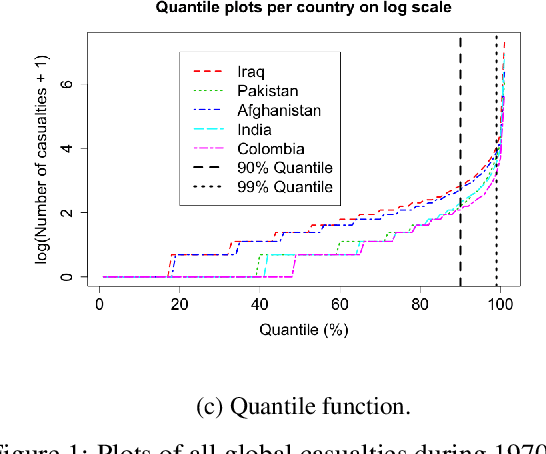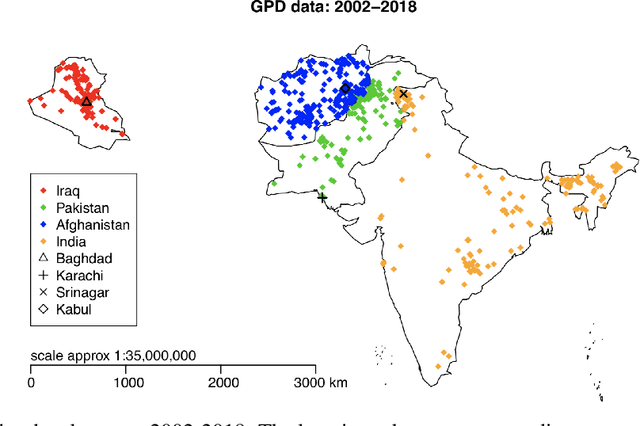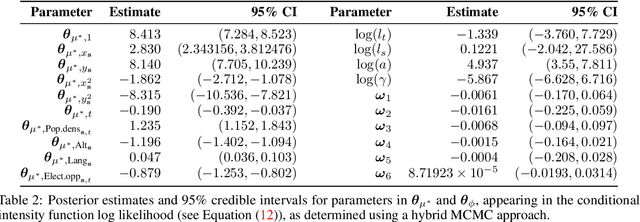Lyndsay Shand
Spatio-temporal extreme event modeling of terror insurgencies
Oct 29, 2021



Abstract:Extreme events with potential deadly outcomes, such as those organized by terror groups, are highly unpredictable in nature and an imminent threat to society. In particular, quantifying the likelihood of a terror attack occurring in an arbitrary space-time region and its relative societal risk, would facilitate informed measures that would strengthen national security. This paper introduces a novel self-exciting marked spatio-temporal model for attacks whose inhomogeneous baseline intensity is written as a function of covariates. Its triggering intensity is succinctly modeled with a Gaussian Process prior distribution to flexibly capture intricate spatio-temporal dependencies between an arbitrary attack and previous terror events. By inferring the parameters of this model, we highlight specific space-time areas in which attacks are likely to occur. Furthermore, by measuring the outcome of an attack in terms of the number of casualties it produces, we introduce a novel mixture distribution for the number of casualties. This distribution flexibly handles low and high number of casualties and the discrete nature of the data through a {\it Generalized ZipF} distribution. We rely on a customized Markov chain Monte Carlo (MCMC) method to estimate the model parameters. We illustrate the methodology with data from the open source Global Terrorism Database (GTD) that correspond to attacks in Afghanistan from 2013-2018. We show that our model is able to predict the intensity of future attacks for 2019-2021 while considering various covariates of interest such as population density, number of regional languages spoken, and the density of population supporting the opposing government.
An efficient approach for tracking the aerosol-cloud interactions formed by ship emissions using GOES-R satellite imagery and AIS ship tracking information
Aug 20, 2021



Abstract:Ship emissions can form linear cloud features, or ship tracks, when atmospheric water vapor condenses on aerosols in the ship exhaust. These features are of interest because they are observable and traceable examples of marine cloud brightening, a mechanism that has been studied as a potential approach for solar climate intervention. Ship tracks can be observed throughout the diurnal cycle via space-borne assets like the Advanced Baseline Imagers on the National Oceanic and Atmospheric Administration Geostationary Operational Environmental Satellites, the GOES-R series. Due to complex atmospheric dynamics, it can be difficult to track these aerosol perturbations over space and time to precisely characterize how long a single emission source can significantly contribute to indirect radiative forcing. We combine GOES-17 satellite imagery with ship location information to demonstrate two feasible methods of tracing the trajectories of ship-emitted aerosols after they begin mixing with low boundary layer clouds in three test cases. The first method uses the parcel trajectory model HYSPLIT, which was driven by well-studied physical processes but often could not follow the ship track beyond 8 hours. The second method uses the image processing technique, optical flow, which could follow the track throughout its lifetime, but requires high contrast features for best performance. These approaches show that ship tracks persist as visible, linear features beyond 9 hr and sometimes longer than 24 hr. This research sets the stage for a more thorough exploration of the atmospheric conditions and exhaust compositions that produce ship tracks and factors that determine track persistence.
 Add to Chrome
Add to Chrome Add to Firefox
Add to Firefox Add to Edge
Add to Edge